


xxxxxIn 1812 the English poet George Gordon Byron (Lord Byron) gained overnight success with the first part of his Childe Harold’s Pilgrimage. Tracing the journey of a moody, disillusioned young man as he travelled across distant, exotic places, it caught the public’s imagination. A string of similar verse tales, made attractive by their foreign landscapes and historical settings, also proved popular, but by 1816 his life of debauchery -
GEORGE GORDON BYRON (LORD BYRON) 1788 -
Acknowledgements
Byron: by the English portrait painter Richard Westall (1765-
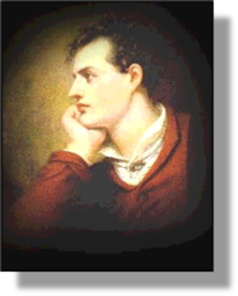 xxxxxThe English poet George Gordon Byron was born in London, and at the age of ten unexpectedly inherited the title and estates of his great uncle William, the 5th Baron Byron. He and his mother went to live at Newstead Abbey, the dilapidated ancestral home in Nottinghamshire, and after attending Harrow School, near London, he went up to Trinity College, Cambridge. Here he enjoyed a life of leisure and debauchery, accumulated substantial debts and, being bisexual by nature, fell in love with a young choirboy. His first work, Hours of Idleness, published in 1807, was not particularly well received in the columns of the Edinburgh Review and, characteristically, he took his critics to task two years later in a highly satirical poem entitled English Bards and Scotch Reviewers.
xxxxxThe English poet George Gordon Byron was born in London, and at the age of ten unexpectedly inherited the title and estates of his great uncle William, the 5th Baron Byron. He and his mother went to live at Newstead Abbey, the dilapidated ancestral home in Nottinghamshire, and after attending Harrow School, near London, he went up to Trinity College, Cambridge. Here he enjoyed a life of leisure and debauchery, accumulated substantial debts and, being bisexual by nature, fell in love with a young choirboy. His first work, Hours of Idleness, published in 1807, was not particularly well received in the columns of the Edinburgh Review and, characteristically, he took his critics to task two years later in a highly satirical poem entitled English Bards and Scotch Reviewers.
xxxxxIn that same year, 1809, he embarked on a grand continental tour with John Cam Hobhouse, a friend he had made at Cambridge. They sailed to Lisbon, travelled across Spain, and reached Greece by way of Gibraltar and Malta. Here he found the warm weather and the moral tolerance of the Greeks much to his liking. They then journeyed to Constantinople before returning to England, arriving there in July 1811. This tour gave him the backcloth for his romantic poem Childe Harold’s Pilgrimage, started during his travels. The first two cantos of this verse tale, published in 1812, were a huge overnight success. Describing the journey of a disillusioned, broody young man as he travelled to faraway places and became embroiled in dramatic events, it caught the imagination of the public. “I woke up one morning”, Byron later wrote, “and found myself famous!”
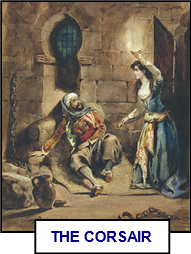
xxxxxOver the next four years he followed up this phenomenal success with a string of equally gloomy, self-
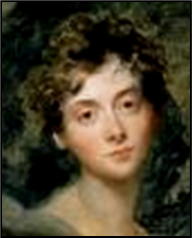 xxxxxBut his literary success, immense though it was, was soon overshadowed by the excesses of his private life. Indeed much of his writing at this time reflected his own mixed feelings, ranging through a gamut of sensations from guilt to euphoria. Young and handsome, of noble birth, and a rebel against society, he was never short of admirers. His many love affairs and conquests in these years included Lady Oxford and the eccentric Lady Caroline Lamb (illustrated), who regarded her lover as “mad, bad and dangerous to know”. In January 1815 he married the somewhat plain and serious-
xxxxxBut his literary success, immense though it was, was soon overshadowed by the excesses of his private life. Indeed much of his writing at this time reflected his own mixed feelings, ranging through a gamut of sensations from guilt to euphoria. Young and handsome, of noble birth, and a rebel against society, he was never short of admirers. His many love affairs and conquests in these years included Lady Oxford and the eccentric Lady Caroline Lamb (illustrated), who regarded her lover as “mad, bad and dangerous to know”. In January 1815 he married the somewhat plain and serious-
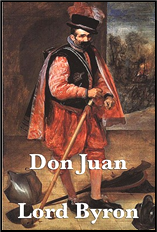
xxxxxHe sailed up the Rhine and settled for a while in Geneva in a villa overlooking the lake. Here he met up with Percy Bysshe Shelley and Mary Godwin (the future Mary Shelley), and began writing his poetic drama Manfred, a pessimistic reflection upon man’s earthly stay which doubtless mirrored his own frame of mind at this time. And to this period belongs the third canto of Childe Harold and the narrative poem The Prisoner of Chillon. From Geneva he moved to Venice, and it was here at the Plazzo Mocenigo on the Grand Canal that he began work on his masterpiece Don Juan. In this long serious-
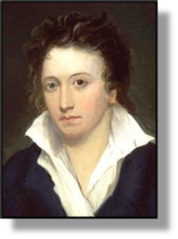
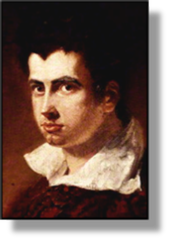 xxxxxMeanwhile, however, his private life had again become the subject of much gossip in Venetian society, despite its more tolerant attitude towards amorous pursuits. Perhaps because of this, in 1819 he took off once more, travelling around northern Italy. In Pisa he again met Shelley (illustrated left), and in early 1822 they went to Leghorn (now Livorno) to meet up with the poet Leigh Hunt (illustrated right). Together they produced a radical journal The Liberal, and, despite the tragic death of Shelley, drowned off the coast of Italy in the July, a number of issues were published. The first one contained The Vision of Judgment, a brilliant satirical parody in response to criticism made of him by the poet Robert Southey. Also produced at this time was his narrative poem Mazeppa, based on a Cossack leader’s fight for the independence of the Ukraine. And by then, too, he had started an affair with the Countess Teresa Gambia Guiccioli, a young married woman. Through her family he became a member of the Carbonari, and gave money in support of this revolutionary movement to free Italy from Austrian rule.
xxxxxMeanwhile, however, his private life had again become the subject of much gossip in Venetian society, despite its more tolerant attitude towards amorous pursuits. Perhaps because of this, in 1819 he took off once more, travelling around northern Italy. In Pisa he again met Shelley (illustrated left), and in early 1822 they went to Leghorn (now Livorno) to meet up with the poet Leigh Hunt (illustrated right). Together they produced a radical journal The Liberal, and, despite the tragic death of Shelley, drowned off the coast of Italy in the July, a number of issues were published. The first one contained The Vision of Judgment, a brilliant satirical parody in response to criticism made of him by the poet Robert Southey. Also produced at this time was his narrative poem Mazeppa, based on a Cossack leader’s fight for the independence of the Ukraine. And by then, too, he had started an affair with the Countess Teresa Gambia Guiccioli, a young married woman. Through her family he became a member of the Carbonari, and gave money in support of this revolutionary movement to free Italy from Austrian rule.
xxxxxBy 1823 Byron had moved to Genoa to live with Teresa, but domestic life did not fit in with his temperament. Inspired by the efforts then being made by the Greeks to overthrow their Turkish masters, he raised a small rebel band and in the July set out for the island of Cephalonia off the west coast of Greece. There he helped to prepare the Greek fleet for action, contributing to the cost, and then made for the port of Missolonghi to join the rebel forces.
xxxxxOn arrival at Missolonghi he was made a brigade commander and, so we are told, did much to rally the troops for their task ahead, but at the beginning of April 1824 he was taken ill with a fever and died later that month. “It is proper that I should remain in Greece,” he is alleged to have said during his illness, “and it is better to die doing something rather than nothing”.
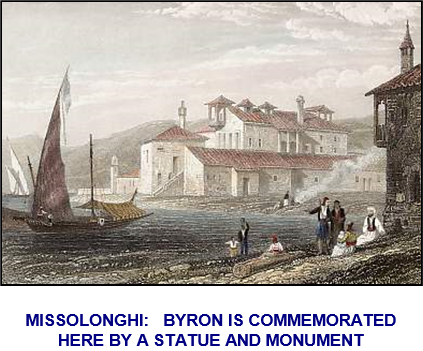 xxxxxHe died a Greek national hero, and his death and the manner of it, “came upon London like an earthquake”, as one newspaper put it. The English writer Thomas Carlyle spoke for many when he said that Byron was the noblest spirit in Europe. Regardless of his earlier indiscretions, there was much to be admired in a man of noble birth and literary talent who was prepared to fight and die for the weak and oppressed -
xxxxxHe died a Greek national hero, and his death and the manner of it, “came upon London like an earthquake”, as one newspaper put it. The English writer Thomas Carlyle spoke for many when he said that Byron was the noblest spirit in Europe. Regardless of his earlier indiscretions, there was much to be admired in a man of noble birth and literary talent who was prepared to fight and die for the weak and oppressed -
xxxxxAs a writer and, indeed, as a person, Byron exemplified the wayward spirit of the romantic movement, with its bitter rejection of social conformity, its love of the exotic, and its bounding enthusiasm for political as well as personal freedom. Indeed, so popular did his works become, and so well known his private life, that he himself came to personify Romanticism and Liberalism throughout Europe. The moody, melancholy aloofness of Childe Harold -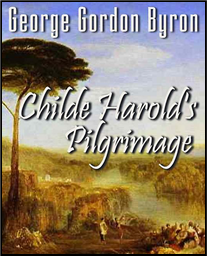 und Drang movement and European literature in general. Particularly influenced were French writers like Victor Hugo, Alphonse de Lamartine, Alfred de Vigny and Alfred de Musset, but his impact was felt as far away as Russia, where the writer Alekandre Pushkin particularly admired his verse.
und Drang movement and European literature in general. Particularly influenced were French writers like Victor Hugo, Alphonse de Lamartine, Alfred de Vigny and Alfred de Musset, but his impact was felt as far away as Russia, where the writer Alekandre Pushkin particularly admired his verse.
xxxxxAmong Byron’s other works were the biblical “mystery” Cain, the tragedy Sardanapalus, woven around the legendary king of Assyria, and The Island, based on the mutiny on the Bounty in 1789 -
xxxxxIncidentally, it is not always appreciated that Byron was badly crippled all his life. He was born with a badly deformed right foot and lower leg. He often walked with a limp, but the full extent of his disability was not realised until his friend, Edward John Trelawny, examined Byron’s corpse soon after arriving at Missolonghi. Later, recording his discovery, he wrote: “This was a curse, chaining a proud and soaring spirit like his to the dull earth”. ……
xxxxx…… Byron’s Turkish tale The Bride of Abydos refers to the Greek legend Hero and Leander, a tragic love story in which Leander is drowned one stormy night while swimming across the Hellespont (now the Dardanelles) to visit his loved one. When Byron visited Turkey in 1810 he decided to swim across this narrow strait to prove that it could be done. Despite his physical handicap, he succeeded at the third attempt! ……
xxxxx…… When up at Cambridge, Byron used to keep a tame bear in his rooms. Later in life, when living in Venice, he kept a small zoo in his apartments. ……
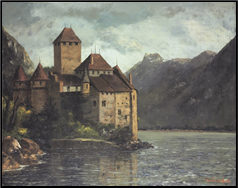
xxxxx…… His Prisoner of Chillon was inspired by a visit he once made to the castle of Chillon near Montreux in Switzerland. There he learnt of the plight of Bonivard, the prior of St. Victor’s, Geneva, who, arrested for supporting the city’s independence movement, was chained to a pillar in the dungeon and kept shackled there for four years. He was eventually freed in 1536. During his visit Byron signed his name on one of the pillars. ……
xxxxx…… EdwardxJohn Trelawny (1792-
xxxxxA few of Byron’s more memorable lines are given below:
The Assyrian came down like the wolf on the fold,
And his cohorts were gleaming in purple and gold;
And the sheen of their spears was like stars on the sea,
When the blue wave rolls nightly on deep Galilee. ….
And there lay the rider, distorted and pale,
With the dew on his brow and the rust on his mail;
And the tents were all silent, the banners alone,
The lances unlifted, the trumpet unblown. (The Destruction of Sennacherib)
-
The isles of Greece, the isles of Greece!
Where burning Sappho loved and sung,
Where grew the arts of war and peace,
Where Delos rose, and Phoebus sprung!
Eternal summer gilds them yet,
But all, except their sun, is set. ….
The mountains look on Marathon –
And Marathon looks on the sea;
And musing there an hour alone,
I dream’d that Greece might still be free;
For standing on the Persians’ grave,
I could not deem myself a slave. (Don Juan)
-
She walks in beauty, like the night
Of cloudless climes and starry skies;
And all that’s best of dark and bright
Meet in her aspect and her eyes:
Thus mellow’d to that tender light
Which heaven to gaudy day denies.
And on that cheek, and o’er that brow,
So soft, so calm, yet eloquent,
The smiles that win, the tints that glow,
But tell of days in goodness spent,
A mind at peace with all below,
A heart whose love is innocent. (Hebrew Melodies)
-
All tragedies are finished by a death,
All comedies are ended by a marriage. (Don Juan)
-
There is a tide in the affairs of women
Which taken at the flood, leads -
-
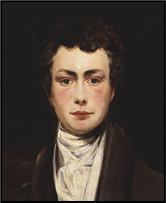
xxxxxThexIrish poet and satirist Thomas Moore (1779-
G3c-


